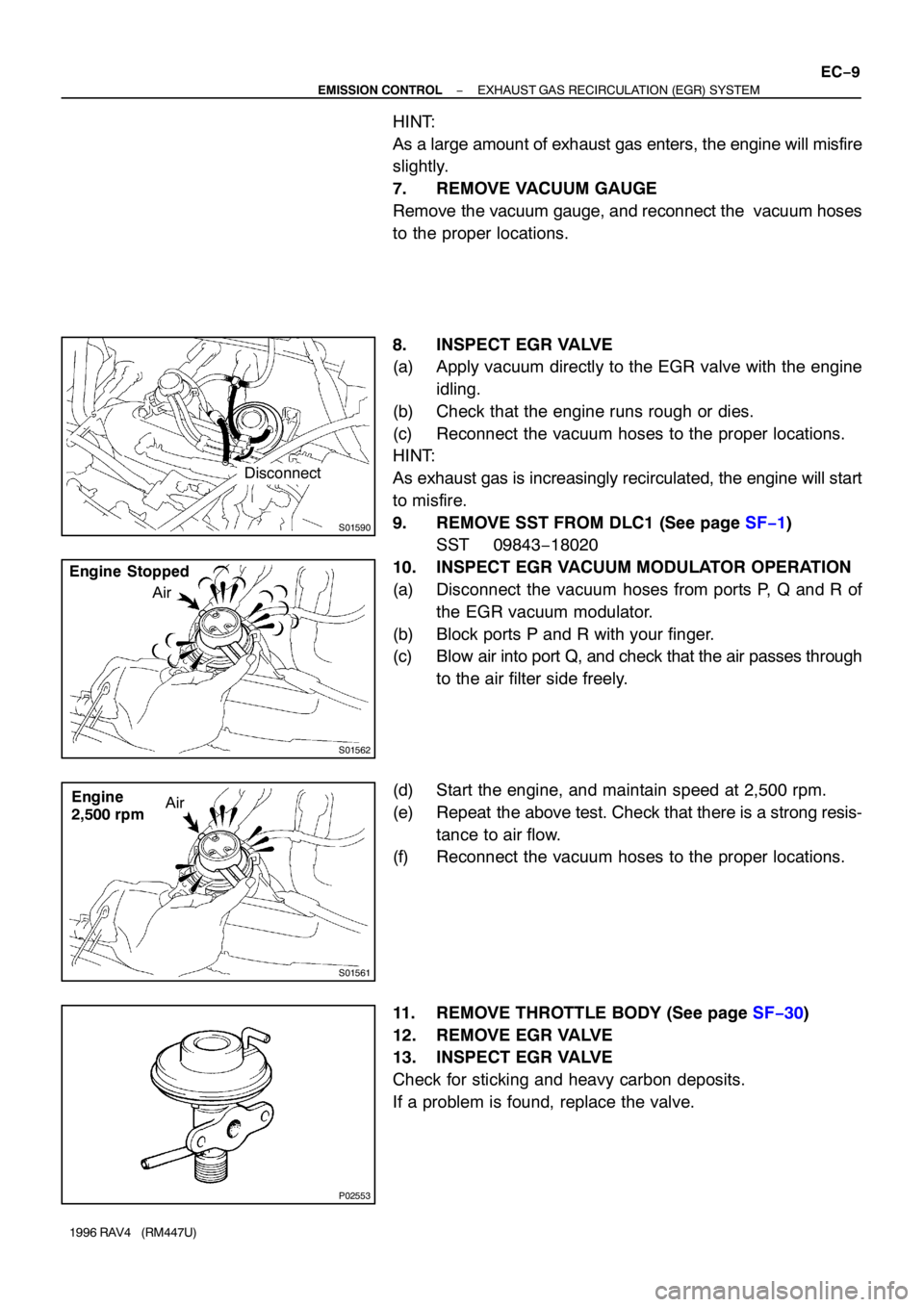Page 636 of 1354
N14701
(−)ECT
(+)
− DIAGNOSTICSCRUISE CONTROL SYSTEM
DI−359
1996 RAV4 (RM447U)
3 Check voltage between terminal ECT of cruise control ECU connector and body
ground (On test drive).
PREPARATION:
(a) Connect ECU connector.
(b) Test drive after engine warm up.
CHECK:
Check voltage between terminal ECT of cruise control ECU
connector and body ground when OD switch is on and off.
OK:
Gear PositionVoltage
O/DBelow 1 V
3rd10 − 16 V
OK Proceed to next circuit inspection shown on
matrix chart (See page DI−336).
NG
4 Check for open and short in harness and connector between terminal ECT of
cruise control ECU and electronically controlled transaxle solenoid
(See page IN−30).
NG Repair or replace harness or connector.
OK
Check and repair ECU.
5 Check for open and short in harness and connector between terminal OD of ECU
and terminal OD1 of ECM (See page IN−30).
NG Repair or replace harness or connector.
OK
Check and replace ECU.
Page 637 of 1354
N17900
Park/Neutral
Position Switch
P1
P1IG11
10
8
E66
B−WCruise Control ECU
D
*1*2
ECM
DB−W
B−WB−W
*1 FF
*2: 4WD
DI−360
− DIAGNOSTICSCRUISE CONTROL SYSTEM
1996 RAV4 (RM447U)
Park/Neutral Position Switch Circuit
CIRCUIT DESCRIPTION
When the shift position is put in except D position, a signal is sent from the park/neutral position switch to
the ECU. When this signal is input during cruise control driving, the ECU cancels the cruise control.
WIRING DIAGRAM
INSPECTION PROCEDURE
1 Check operation of starter.
CHECK:
Check that the starter operates normally and that the engine starts.
NG Proceed to engine troubleshooting
(See page DI−1).
OK
DI42V−02
Page 640 of 1354
N17901
− DIAGNOSTICSCRUISE CONTROL SYSTEM
DI−363
1996 RAV4 (RM447U)
Clutch Switch Circuit
CIRCUIT DESCRIPTION
When the clutch pedal is depressed, the clutch switch sends a signal to the cruise control ECU, when this
signal is input to the cruise control ECU during cruise control driving, the cruise control ECU cancels cruise
control.
WIRING DIAGRAM
INSPECTION PROCEDURE
1 Check operation of starter.
CHECK:
Check that the starter operates normally and that the engine starts.
NG Proceed to engine troubleshooting
(See page DI−1).
OK
DI42W−02
Page 654 of 1354
EC05E−01
− EMISSION CONTROLEMISSION CONTROL SYSTEM
EC−1
1996 RAV4 (RM447U)
EMISSION CONTROL SYSTEM
PURPOSE
The emission control systems are installed to reduce the amount of HC, CO and NOx exhausted from the
engine ((3), (4) and (5)), to prevent the atmospheric release of blow−by gas−containing HC (1) and evapo-
rated fuel containing HC being released from the fuel tank (2).
The function of each system is shown in the following table.
SystemAbbreviationFunction
(1) Positive Crankcase Ventilation
(2) Evaporative Emission Control
(3) Exhaust Gas Recirculation
(4) Three−Way Catalytic Converter
(5) Sequential Multiport Fuel Injection*PCV
EVAP
EGR
TWC
SFIReduces HC
Reduces evaporated HC
Reduces NOx
Reduces HC, CO and NOx
Injects a precisely timed, optimum amount of fuel for reduced
exhaust emissions
Remark: * For inspection and repair of the SFI system, refer to the SFI section in this manual.
Page 661 of 1354

EC05K−03
S01587
Cap
Filter
S01588
Vacuum
Gauge
S01261
DLC1
TE1
E1SST
S01589
High Vacuum
at 2,500 rpm
Port R
Disconnect HOT EC−8
− EMISSION CONTROLEXHAUST GAS RECIRCULATION (EGR) SYSTEM
1996 RAV4 (RM447U)
INSPECTION
1. INSPECT AND CLEAN FILTER IN EGR VACUUM MOD-
ULATOR
(a) Remove the cap and filter.
(b) Check the filter for contamination or damage.
(c) Using compressed air, clean the filter.
(d) Reinstall the filter and cap.
HINT:
Install the filter with the coarser surface facing the atmospheric
side (outward).
2. INSTALL VACUUM GAUGE
Using a 3−way connector, connect a vacuum gauge to the hose
between the EGR valve and VSV.
3. INSPECT SEATING OF EGR VALVE
Start the engine and check that the engine starts and runs at
idle.
4. CONNECT TERMINALS TE1 AND E1 OF DLC1
Using SST, connect terminals TE1 and E1 of the DLC1
SST 09843−18020
5. INSPECT VSV OPERATION WITH COLD ENGINE
(a) The engine coolant temperature should be below
55°C (131°F).
(b) Check that the vacuum gauge indicates zero at 2,500
rpm.
6. INSPECT OPERATION OF VSV AND EGR VACUUM
MODULATOR WITH HOT ENGINE
(a) Warm up the engine to above 60°C (140°F).
(b) Check that the vacuum gauge indicates low vacuum at
2,500 rpm.
(c) Disconnect the vacuum hose port R of the EGR vacuum
modulator and connect port R directly to the intake man-
ifold with another hose.
(d) Check that the vacuum gauge indicates high vacuum at
2,500 rpm.
Page 662 of 1354

S01590
Disconnect
S01562
Engine Stopped
Air
S01561
Engine
2,500 rpmAir
P02553
− EMISSION CONTROLEXHAUST GAS RECIRCULATION (EGR) SYSTEM
EC−9
1996 RAV4 (RM447U)
HINT:
As a large amount of exhaust gas enters, the engine will misfire
slightly.
7. REMOVE VACUUM GAUGE
Remove the vacuum gauge, and reconnect the vacuum hoses
to the proper locations.
8. INSPECT EGR VALVE
(a) Apply vacuum directly to the EGR valve with the engine
idling.
(b) Check that the engine runs rough or dies.
(c) Reconnect the vacuum hoses to the proper locations.
HINT:
As exhaust gas is increasingly recirculated, the engine will start
to misfire.
9. REMOVE SST FROM DLC1 (See page SF−1)
SST 09843−18020
10. INSPECT EGR VACUUM MODULATOR OPERATION
(a) Disconnect the vacuum hoses from ports P, Q and R of
the EGR vacuum modulator.
(b) Block ports P and R with your finger.
(c) Blow air into port Q, and check that the air passes through
to the air filter side freely.
(d) Start the engine, and maintain speed at 2,500 rpm.
(e) Repeat the above test. Check that there is a strong resis-
tance to air flow.
(f) Reconnect the vacuum hoses to the proper locations.
11. REMOVE THROTTLE BODY (See page SF−30)
12. REMOVE EGR VALVE
13. INSPECT EGR VALVE
Check for sticking and heavy carbon deposits.
If a problem is found, replace the valve.
Page 667 of 1354

EM0EG−02
S01353
CO/HC Meter
− ENGINE MECHANICALCO/HC
EM−1
1996 RAV4 (RM447U)
CO/HC
INSPECTION
HINT:
This check is used only to determine whether or not the idle CO/
HC complies with regulations.
1. INITIAL CONDITIONS
(a) Engine at normal operating temperature
(b) Air cleaner installed
(c) All pipes and hoses of air induction system connected
(d) All accessories switched OFF
(e) All vacuum lines properly connected
HINT:
All vacuum hoses for EGR systems, etc. should be properly
connected.
(f) SFI system wiring connectors fully plugged
(g) Ignition timing check correctly
(h) Transmission in neutral position
(i) Tachometer and CO/HC meter calibrated by hand.
2. START ENGINE
3. RACE ENGINE AT 2,500 RPM FOR APPROX. 180 SE-
CONDS
4. INSERT CO/HC METER TESTING PROBE AT LEAST
40 cm (1.3 ft) INTO TAILPIPE DURING IDLING
5. IMMEDIATELY CHECK CO/HC CONCENTRATION AT
IDLE AND/OR 2,500 RPM
Complete the measuring within 3 minutes.
HINT:
When performing the 2 mode (2,500 rpm and idle) test, follow
the measurement order prescribed by the applicable local regu-
lations.
Page 668 of 1354

EM−2
− ENGINE MECHANICALCO/HC
1996 RAV4 (RM447U)
6. TROUBLESHOOTING
If the CO/HC concentration does not comply with regulations,
troubleshoot in the order given below.
(a) Check the oxygen sensor operation (See page DI−42).
(b) See the table below for possible causes, then inspect and
correct the applicable causes if necessary.
HCCOProblemsCauses
HighNormalRough idle4. Faulty ignitions:
�Incorrect timing
�Fouled, shorted or improperly gapped plugs
�Open or or crossed high−tension cords
�Cracked distributor cap
5. Incorrect valve clearance
6. Leaky EGR valve
7. Leaky intake and exhaust valves
8. Leaky cylinder
HighLowRough idle
(Fluctuating HC reading)1. Vacuum leaks:
�PCV hose
�EGR valve
�Intake manifold
�Throttle body
�IAC valve
�Brake booster line
2. Lean mixture causing misfire
HighHighRough idle
(Black smoke from exhaust)1. Restricted air filter
2. Faulty SFI system:
�Faulty pressure regulator
�Clogged fuel return line
�Defective ECT sensor
�Defective IAT sensor
�Faulty ECM
�Faulty injector
�Faulty throttle position sensor
�MAP sensor